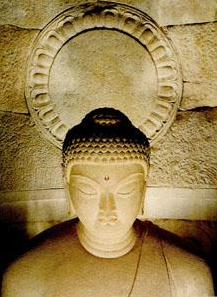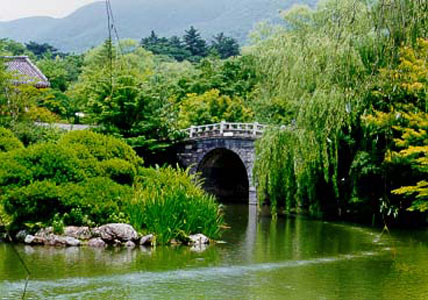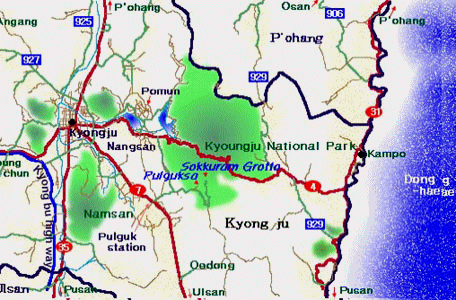 World Heritage SiteSeokguram Grotto, believed to be the eastern terminal of the old Silk Road, is located a considerable distance up Mt. T'oham from Bulguksa Temple in Kyoungju National Park, South Korea. In December of 1995, together with Bulguksa Temple, it was added to the UNESCO World Heritage List. The artistic importance of Seokguram's stone carvings is readily apparent, as the main rotunda, just beyond two imposing pillars with lotus-design bases, is made of large blocks of granite. No wonder the grotto is referred to as a Stone Cave Hermitage. A working Buddhist monastery is in the immediate vicinity. On Sunday, June 25, 1995, I climbed Mt. T'oham with my American buddy and co-worker, Marcus Jackman, to see the Buddha in all his magnificence. I was teaching conversational English in Masan at the time. It was a long, exhausting, almost vertical ascent from Bulguksa, but there was an ice cold Coke machine waiting for us at the top. Buddha and Coca Cola have gone well together ever since. Oh man, pardon me, hmm... Listen to Marcus every Thursday evening at 6:20 EST on Indiana Public Radio here. A Ruling IdeologyCarved during the middle of the 8th century during the reign of the Silla King Kyongdok, Seokguram Grotto's grandeur is definitely related to the increased spreading of Buddhism as a ruling ideology. It has been thought to be the work of Prime Minister Kim Taesong, who also planned Bulguksa Temple to honour the parents of his former life. The placement of the central Buddha statue, so that it gazes precisely in the direction of the underwater tomb of King Munmu located just off the coast in the East Sea, suggests that the grotto may have been built to glorify the king and his royal lineage. The unChoson OneDuring the Choson period, or at least during portions of it, Buddhism was officially discouraged and both Bulguksa and Seokguram fell into disrepair. The story goes that Seokguram Grotto was rediscovered by a Japanese postman taking shelter on the mountain in 1909. The Japanese later confiscated the large diamond implanted in the Buddha's forehead. RestorationThe various attempts to restore the grotto in the twentieth century form a complex narrative in themselves. The complexity and subtlety of engineering that went into the original construction of the stone cave hermitage has often been inadequately appreciated. A Complex Infrastructure of StoneBetween 1913 and 1915, the grotto was dismantled as part of a repair effort by the Japanese. During this restoration, a complex infrastructure of stone was found beneath the visible carvings. The original design had permitted the circulation of air which regulated the temperature of the inner chamber. A total lack of appreciation for this design led to the decision to repair the inner chamber using cement. As a result, air circulation was blocked and the stones began to sweat, leading to a serious water leakage problem. No Major ImprovementsA second reconstruction effort in 1920 focused on waterproofing. It did something to alleviate the immediate threat, but it did not correct the underlying problem. It wasn't until between 1960 and 1964 that a further effort was made under the auspices of UNESCO. Air conditioning and heating were installed to precisely regulate the temperature of the inner chamber. While this restoration stabilized the situation, it is no major improvement over the grotto's original design. A glass barrier now separates visitors from the inner chamber so that the chamber's air temperature can be stabilized.

In My DreamIn my dream I was climbing up the mountain, stopping every now and then by the narrow trail's edge to gaze out over the misty abyss. Soon I would be with the one I had come to see. My breath was short and my past was beating fast. What if he does not recognize me? What if he's only waiting for the sun? Life is taking chances every step of the way. Life is for the living, and can be more frightening than death itself. These were the thoughts that haunted me walking back down the wandering grade. His eyes had been partially closed, but I sensed he had heard my prayer. I remember my spirit reaching out to touch his granite face. It had felt cool and calm, like the glassy green pool awaiting my return to the foot of some steep ascent into my higher self. Om mani padme hum. It takes a strong heart to stand up to its fate. I will plant a dark garden with a soft stone pillow and whispering chimes. Oh, what dreams more shall come...   |